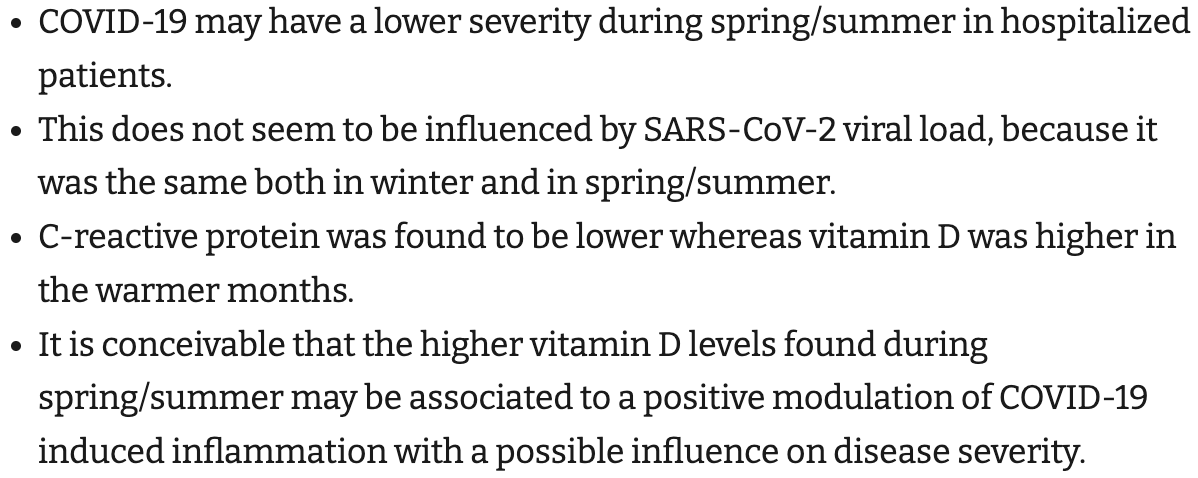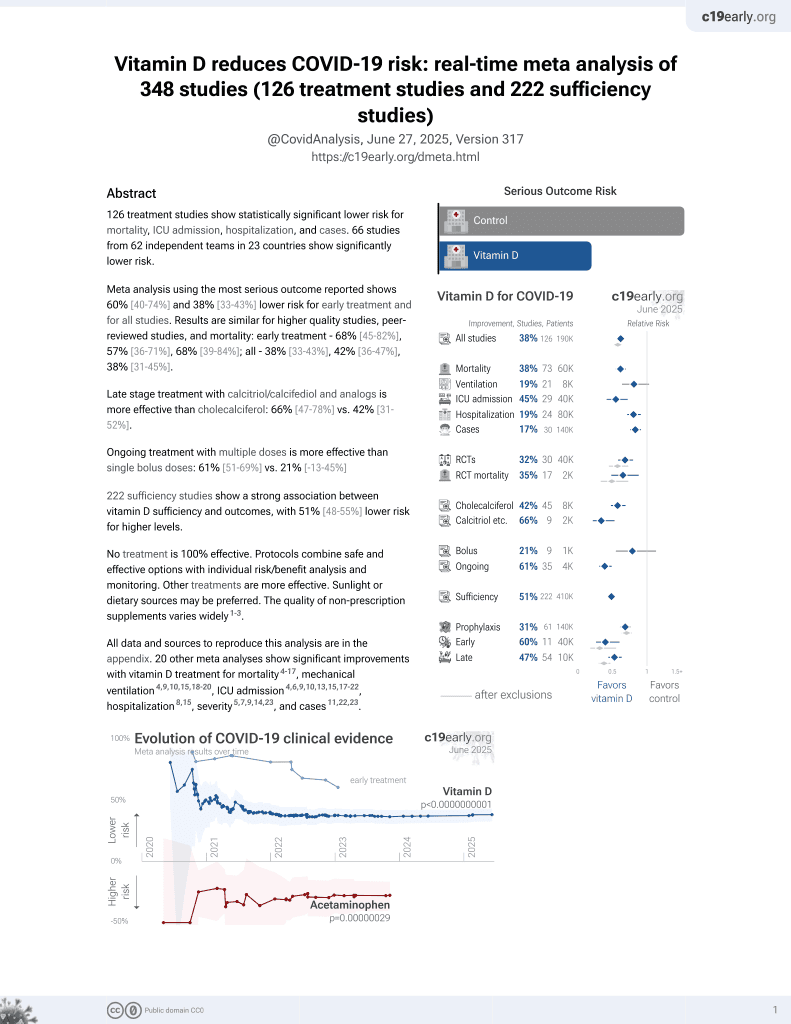
COVID-19 severity appears to be reduced in spring/summer
et al., Epidemiol Prev., doi:10.19191/EP23.1.A503.016, Mar 2023
Vitamin D for COVID-19
8th treatment shown to reduce risk in
October 2020, now with p < 0.00000000001 from 136 studies, recognized in 18 countries.
No treatment is 100% effective. Protocols
combine treatments.
6,300+ studies for
210+ treatments. c19early.org
|
Retrospective 8,221 COVID+ patients in Italy, showing significantly lower ICU admission and CPAP/NIV use in the spring/summer compared to the winter. There was no significant difference in viral load. Vitamin D levels were higher and CRP was lower in the spring/summer.
Sposato et al., 27 Mar 2023, retrospective, Italy, peer-reviewed, 13 authors.
DOI record:
{
"DOI": "10.19191/EP23.1.A503.016",
"ISSN": "1120-9763, 2385-1937",
"URL": "https://doi.org/10.19191/EP23.1.A503.016",
"abstract": "BACKGROUND: because of different human behaviours, SARS-CoV-2 spread may be lower in spring/summer. On the contrary, it is not clearly known whether the clinical course/severity of hospitalized patients infected by SARS-CoV-2 can be different in the various seasons.. Objectives: to understand whether there were differences in severity of COVID-19 in patients who had contracted the infection in winter versus those infected in spring/summer. DESIGN: observational retrospective cohort study. SETTING AND PARTICIPANTS: from the administrative database of the SARS-CoV-2 surveillance system and that of hospital discharge, a cohort of patients (8,221, 653 of which were hospitalized) who tested positive to the RT-PCR test for SARS-CoV-2 between 01.12.2020 and 31.07.2021 in the Grosseto province (Tuscany Region, Central Italy) was selected and analysed. MAIN OUTCOME MEASURES: hospitalization rate and length, continuous positive airway pressure (CPAP) or non-invasive ventilation (NIV) use, Intensive Care Unite (ICU) admissions, intra-hospital mortality and PaO2/FiO2 values were measured and compared between subjects infected in winter and those who developed COVID-19 in spring/summer. Viral load (cycle threshold, Ct), vitamin D, serum ferritin, IL-6, procalcitonin, D-dimer, and C-reactive protein measured in the two periods were also compared. RESULTS: in the considered months, the hospitalization rate among 8,221 patients with COVID-19 was 8%: 370 (8.5%) individuals were hospitalized in winter and 283 (7,3%; p=0.31) in spring/summer; 62 (16.8%), 88 (23.8%), and 63 (17%) in winter and 28 (9.9%), 40 (14.1%), and 36 (12.7%) in spring/summer were admitted in ICU (p=0.01), used CPAP/NIV (p=0.002) and died (p=0.13), respectively. Hospitalization days were 14.5±11.6 in winter and 10.3±8.84 in spring/summer (p=0.001), while minimum PaO2/FiO2, measured during hospital stays was 123.2±38.6 in spring/summer and 112.6±40.8 in winter (p=0.054). Multivariate analysis (adjusted for all confounding factors) also confirmed reduced risks of having ICU admissions (0.53; 95%CI 0.32;0.88; p=0.01) and of using CPAP/NIV (0.48; 95%CI 0.32;0.75; p=0.001) in spring/summer when compared to winter. Hospitalization days and minimum PaO2/FiO2 were also lower in spring/summer (β= -3.9; 95%CI -5.5;-2.2; p=0.001) and winter (β= -17; 95%CI -0.93;35; p=0.06), respectively. The adjusted hazard ratio of mortality in winter, obtained with a Cox model, was higher of about 38% compared to spring/summer. No Ct values (viral load) differences were found either in winter (19.45±6.18) or spring/summer (20.3±6.7; p=0.343). IL-6, ferritin, procalcitonin, D-dimer were similar. Conversely, CRP was lower whereas vitamin D was higher in the warmer seasons. CONCLUSIONS: COVID-19 may be less severe during spring/summer in hospitalized patients. This does not seem to be influenced by different SARS-CoV-2 viral load in the different periods considered. C-reactive protein was found to be lower whereas vitamin D higher in the warmer months. It can be hypothesized that higher levels of vitamin D in spring/summer, compared to winter, may be associated to a positive modulation of COVID-19 induced inflammation with a possible disease severity reduction during spring/summer.",
"author": [
{
"family": "Sposato",
"given": "Bruno"
},
{
"family": "Serafini",
"given": "Andrea"
},
{
"family": "Simoncini",
"given": "Enrico"
},
{
"family": "Croci",
"given": "Leonardo"
},
{
"family": "Guidoni",
"given": "Chiara"
},
{
"family": "Scalese",
"given": "Marco"
},
{
"family": "Baratta",
"given": "Pasquale"
},
{
"family": "Cresti",
"given": "Alberto"
},
{
"family": "Lacerenza",
"given": "Leonardo Gianluca"
},
{
"family": "Lena",
"given": "Fabio"
},
{
"family": "Nencioni",
"given": "Cesira"
},
{
"family": "Spargi",
"given": "Genni"
},
{
"family": "Perrella",
"given": "Antonio"
}
],
"container-title": "Epidemiologia & Prevenzione",
"container-title-short": "E&P",
"issue": "1-2",
"issued": {
"date-parts": [
[
2023,
3
]
]
},
"journalAbbreviation": "E&P",
"keyword": "COVID-19; SARS-CoV-2; viral load; severity; inflammation; season; vitamin D",
"medium": "JB",
"publisher": "Inferenze scarl",
"publisher-place": "IT",
"title": "In primavera/estate la gravità del COVID-19 appare ridotta",
"type": "article-journal",
"volume": "47"
}
